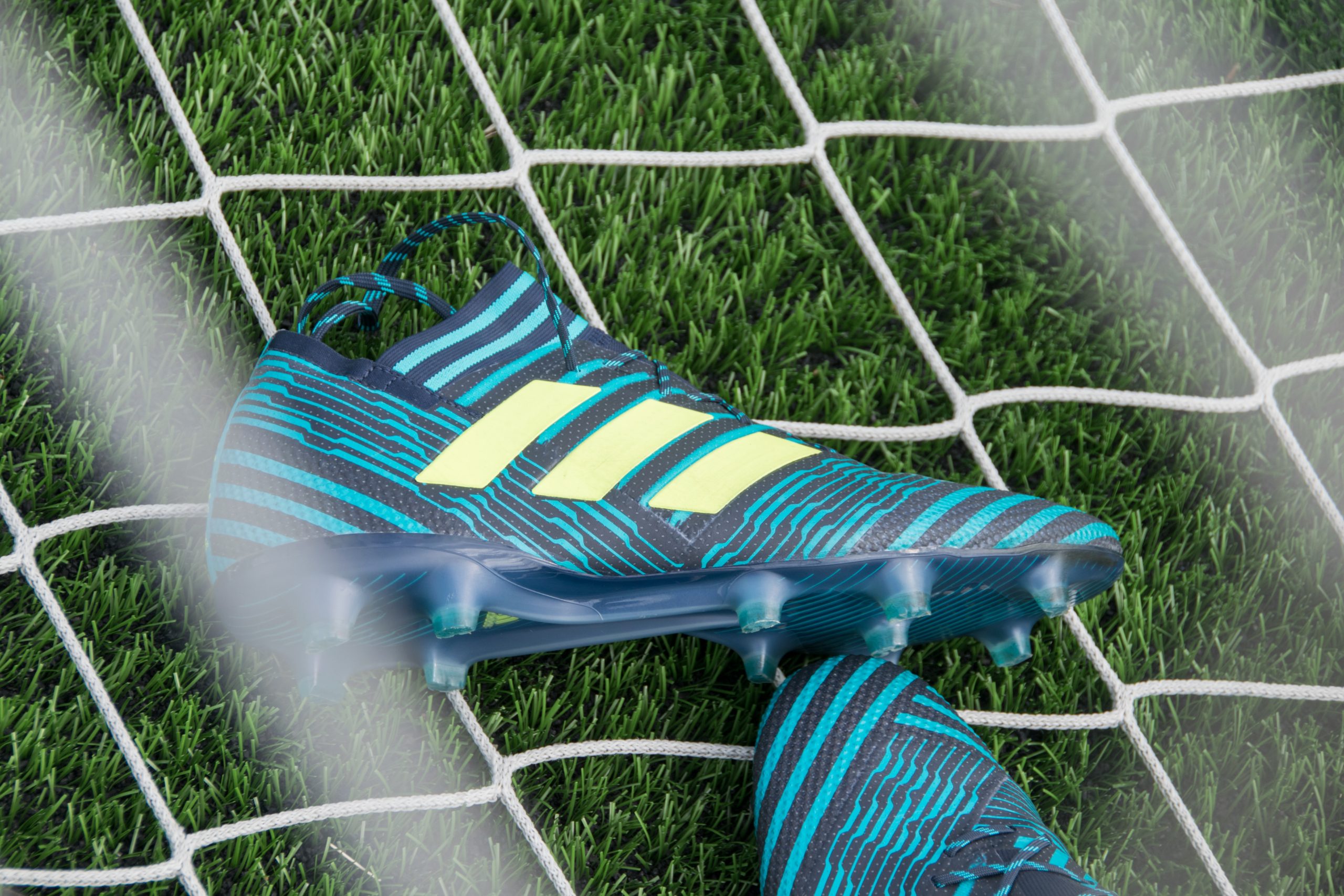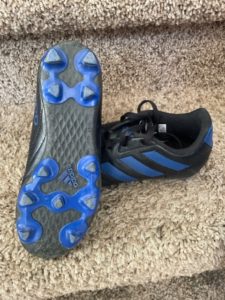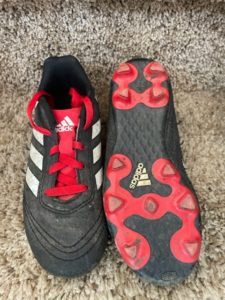When walking through a sporting goods store you may notice how similar looking the football cleats are to the soccer cleats.
This may leave you wondering, Are football cleats and soccer cleats the same?
Along with this, for the most part, both sports are played on the same terrain in organized sports.
However, there are some key differences in the cleats today that specialize each cleat to its respective sport.
According to Adidas, “Cleats for football have thicker outsoles and a stud near the big toe for traction when you push off from a static position.
Soccer cleats don’t include a midsole, so players can maximize their speed and ball-handling maneuvers.
Football cleats do have midsoles to provide much-needed stability and comfort”.
Contents
Key Differences Between Football Cleats and Soccer Cleats
| Category | Football Cleats | Soccer Cleats |
|---|---|---|
| Design | Football cleats are designed for traction and support on grass or turf surfaces. They have longer studs or cleats that can dig into the ground for better grip. | Soccer cleats are designed for agility and control on grass or artificial turf surfaces. They have shorter studs or cleats that allow for quick movements and changes of direction. |
| Material | Football cleats are often made of leather or synthetic materials that provide durability and protection for the foot. | Soccer cleats are often made of lightweight materials like synthetic leather or mesh to allow for better control and touch on the ball. |
| Shape | Football cleats have a more rounded shape with a wider toe box to accommodate the foot when kicking. | Soccer cleats have a more streamlined shape with a narrower toe box to allow for better ball control and touch. |
| Stud Configuration | Football cleats often have a mix of longer and shorter studs or cleats to provide stability and grip on different surfaces. | Soccer cleats often have a uniform stud or cleat pattern to allow for quick movements and changes of direction. |
| Position-Specific | Football cleats come in different styles for different positions, such as lineman, quarterback, or wide receiver. | Soccer cleats are often not position-specific, but some models may be designed for forwards or defenders based on their needs for speed or protection. |
Below are some of the key differences between soccer and football cleats:
1. Low, Medium, and High top options for football cleats
The first difference between football cleats and soccer cleats is that football cleats have low, medium, and high-top options.
As a result of this, if you see a medium or high-top cleat, it is most likely a football cleat.
These high-top designs allow for more protection around the ankles and shins.
2. Soccer Cleats are mostly Low-cut
The second difference between soccer and football cleats is that while most football cleats are mid or high-tops, most soccer cleats are low-cut.
This low-cut design is utilized in soccer to allow players to run faster with a lighter-weight shoe.
While low-cut soccer cleats are the most popular, medium-cut cleats may be a safer option. It provides more ankle support when making cuts.
3. Stud layout (No toe spike on soccer cleats)
The next difference between the two cleats is the stud layout. The main difference between the two is that soccer cleats do not have a front stud while football cleats do.
According to Juvent US San Diego, the reason for this is, “The front stud/spike in football cleats helps with traction on acceleration and jumping.
Especially when you are blocking/tackling or pushing forward”.
4. Soccer shoes are lighter
Another difference between soccer cleats and football cleats is that soccer cleats weigh less than football cleats.
On average, soccer cleats are around 4-5 ounces lighter than football cleats.
While this may not seem like much on paper, this can feel like a world of difference while playing.
According to The Champ Lair, “Football cleats weigh 11 to 15 on average, whereas soccer cleats weigh 7 to 10.
This is because football players need to be agile and change directions sharply. Soccer players must also be able to feel the ball and be lighter on their feet”.
5. Shape of cleats
Shape is another difference between football cleats and soccer cleats.
While they are very similarly shaped, the main difference in the shape is a result of the stud/spike placement.
6. Thinner material for soccer/Thicker for football
The final difference that we will cover between soccer cleats and football cleats is the material that is used to make them.
Typically, in soccer cleats, you will find a much thinner material than you would in a football cleat.
The reason behind this is so the soccer cleat can be more lightweight, making it easier to make quicker and smaller cuts.
On the flip side, the thicker material in the football cleat allows for more protection around the ankles.
Along with this, it allows for more support and resistance when being pushed.
Can you wear football or baseball cleats for soccer?
While some parents think that only one pair of football cleats will get their kid through the year if they play soccer along with football or soccer, however, this is not the case.
Soccer referees do not even allow players to participate in the game if they are wearing football or baseball cleats.
The reason behind this is that both of these cleats have a spike in them that makes things like soccer slides and tackles very dangerous.
Hypothetically, if you were to remove the spike from the cleat, you probably could get away with this, however, the results would vary from referee to referee.
Can my kid wear soccer cleats for football?
Another question from parents is if their child can wear soccer cleats for football.
While players technically can wear soccer cleats in football games, it may not be the best idea.
As previously mentioned, football cleats provide much more protection to the feet and ankles than soccer cleats.
Along with this, soccer cleats are lighter than football cleats. As a result of this, wearing soccer cleats in a football game is a one-way ticket to getting your feet stomped.
Pairing this with the lack of ankle support could lead to serious injuries to the feet and ankles.
What are the different types of soccer cleats?
There are three major types of soccer cleats on the market. These three types are turf, indoor, and firm ground cleats.
Turf soccer cleats are designed specifically for turf. Along with this, the shoe features spikes and treads that are designed to be used on turf.
The second kind of soccer cleat is indoor soccer cleats.
These cleats typically have a flat outsole and do not have any spikes on them. The only case you should probably buy these is if you or your child are in an indoor soccer league.
The final kind of soccer cleat is firm ground cleats.
These are best for actual grass.
History behind Soccer and Football Cleats?
Soccer cleats were invented around 1925 by the Dassler Brothers Shoe Factory.
These were the first cleats with interchangeable studs that made them wearable no matter the field conditions.
Football cleats date back to the early 1900s when the first version of cleats was known as “Mud cleats” designed to help prevent players from slipping.
Summary
In conclusion, there are many differences between wearing soccer cleats and football cleats.
The main differences are football cleats having low, medium, and high cuts, soccer cleats mostly being low cut, the stud layout, the style, soccer cleats weighing less, the shape, and soccer cleats being made of a thinner material.
Along with this, you can not wear football or baseball cleats for soccer games. Along with this, you should not wear soccer cleats for football games.
The major types of cleats are turf, indoor, and firm ground cleats. Finally, soccer cleats were invented in 1925 around 1925 by the Dassler Brothers Shoe Factory.




